
by Amy Mullins, PhD, RDN | Oct 9, 2020
By Matthew Poland and Amy Mullins, MS, RDN
Air fryers have become quite popular over the past few years, touted as a healthier alternative to deep-frying foods, while replicating the crispiness we all love. As a frequent user of an air fryer, I find times where I will catch myself talking family’s or friend’s ears off about how much I love my air fryer and how they should invest in one, too. Here are 3 reasons why an air fryer makes a great tool for any kitchen:
Health, Texture and Taste
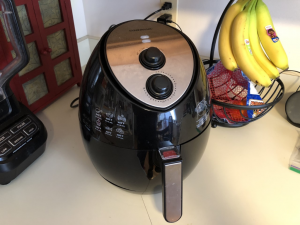
Air fryers crisp food without the fat and calories of deep-frying.
Photo source: Matthew Poland
In my opinion, the number one reason to purchase an air fryer is the ability to make healthy alternatives to classically unhealthy foods. Fried foods consistently are given a thumbs-down from dietitians and other health professionals because the process of deep-frying foods exponentially increases their calorie content due to the nature of submerging foods in oils. However, a large reason why fried foods are so appealing is because of their texture. Deep-frying a food, specifically a breaded food, produces a crunchy exterior and a moist interior we’ve come to love. This is where an air fryer shines. Air fryers use circulating hot air to produce a very similar texture and taste to deep-fried foods, but can use up to 99% less oil (or even no oil), reducing calories by 70-80%, without sacrificing much in flavor (1).
Now, with anything, moderation is key, and this is not a suggestion to have chicken fingers and homemade French fries every night, just because they can be made healthier in an air fryer. However, this is a recommendation to curb cravings of greasy, high-calorie fast food meals by making them at home in an air fryer. In addition, the texture created by an air fryer is a perfect way to expand your dietary pallet, which leads me to my second reason for getting an air fryer: trying new foods.
New Food Experiences
With many kids, as well as adults, eating vegetables is not a desirable activity. They may be aware of the health benefits of vegetables, but when it comes to getting a vegetable past their nose and mouth, it can be a different story. A variety of preparation methods for vegetables exists, from raw to steaming to boiling. However, outside of roasting vegetables, many of these methods soften the texture of the food, which is often not appetizing to many people. Air frying then becomes the perfect method to produce crunchy, appealing vegetables that may just change some minds on whether or not an individual “likes vegetables.”
But the opportunities to try new foods are certainly not limited to just vegetables. From wings, to chicken kebabs, to eggplant parmesan, to air fried green beans, a wide variety of recipes exists for the air fryer. Often times, these recipes can be just as fast, easy, and even more delicious than using a conventional oven. This leads into my final point: the operation and cost of an air fryer.
Operation and Cost
Another benefit to air fryers is their ability to cook foods more quickly than in conventional ovens (or deep-fryers for that matter!). Air fryers reach cooking temperatures much faster than ovens can, but their small size can limit how much food can be cooked at one time, depending on the model. After a meal, cleanup is quick and easy, requiring only a wipe-down if little oil was used and cleaning maintenance is done regularly. Fortunately, air fryers also do not give off the same whole-house-consuming smells that deep-frying foods do.
Many of what could be considered “middle-of-the-line” models come with pre-programmed options for a variety of popular food choices. With the push of one button, it will let you know when the food is finished! Lastly: the cost of air fryers, which are actually quite reasonably priced. From simple, non-programmable fryers starting at around $40, to very snazzy two-basket, dual-zone fryers at around $150, there are various options to fit your exact needs.
In my experience, the air fryer has deservedly earned a spot on my ever-busy kitchen counter. Though they may not be as versatile as a conventional oven, or as quick as a microwave often, I believe they provide significant upsides that most people can find useful. Even if I haven’t convinced you to immediately run out and buy yourself an air fryer, I hope you have gained some insight into why you can’t stop hearing about them.
Matthew Poland is a Graduate Student in the Department of Food, Nutrition, and Exercise Sciences at Florida State University who is currently working on the Dietetic Internship to become a Registered Dietitian/Nutritionist (RDN).
References:
- Air-Frying: Is It As Healthy As You Think? (2020, August 19). Retrieved September 21, 2020, from https://health.clevelandclinic.org/air-frying-is-it-as-healthy-as-you-think/

by Andrea Albertin | Oct 1, 2020
If your private well was damaged or flooded due to a hurricane or other heavy storm activity, your well water may not be safe to drink. Well water should not be used for drinking, cooking purposes, making ice, brushing teeth, or bathing until it is tested by a certified laboratory for total coliform bacteria and E. coli.
Residents should use bottled, boiled, or treated water until their well water has been tested and deemed safe.
- Boiling: To make water safe for drinking, cooking, or washing, bring it to a rolling boil for at least one minute to kill organisms and then allow it to cool.
- Disinfecting with bleach: If boiling isn’t possible, add 1/8 teaspoon or about 8 drops of fresh unscented household bleach (4 to 6% active ingredient) per gallon of water. Stir well and let stand for 30 minutes. If the water is cloudy after 30 minutes, repeat the procedure once.
- Keep treated or boiled water in a closed container to prevent contamination.
NOTE: Use bottled water for mixing infant formula.
Where can you have your well water tested?
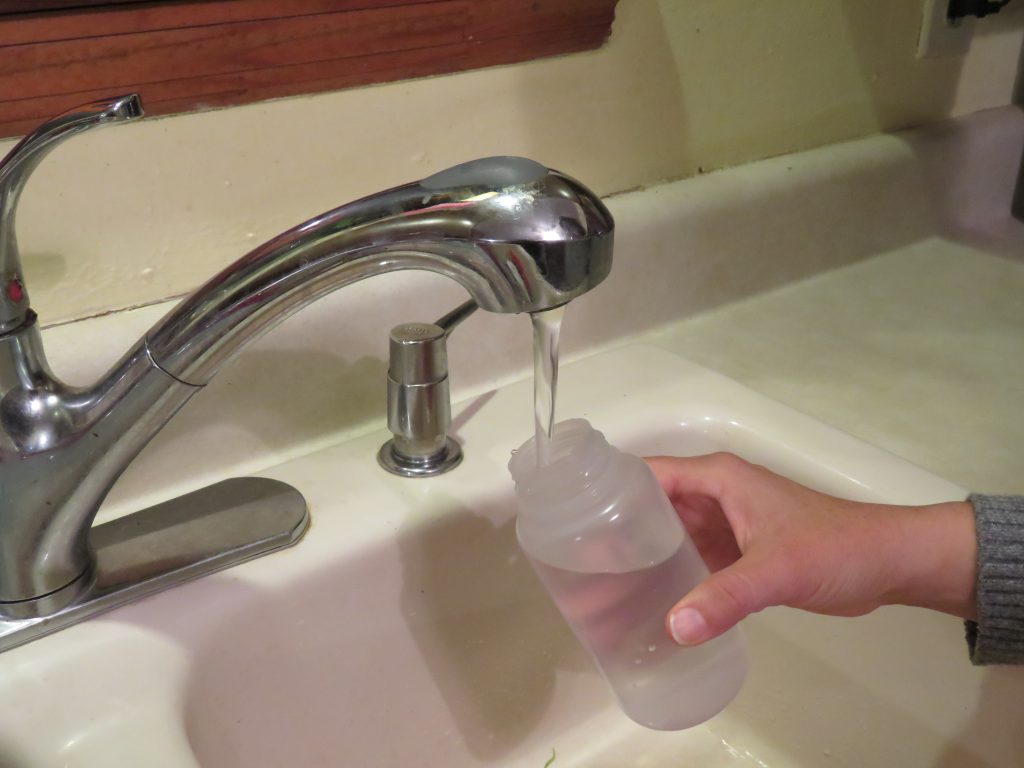
Contact your county health department for information on how to have your well water tested. Image: F. Alvarado Arce
Most county health departments accept water samples for testing. Contact your local department for information about what to have your water tested for (they may recommend more than just for bacteria), and how to collect and submit the sample.
Contact information for Florida Health Departments can be found here: County Health Departments – Location Finder
You can also submit samples to a certified commercial lab near you. Contact information for commercial laboratories that are certified by the Florida Department of Health are found here: Laboratories certified by FDOH. This site includes county health department labs, commercial labs, and university labs; you can search by county.
What should you do if your well water sample tests positive for bacteria?
The Florida Department of Health recommends well disinfection if water samples test positive for total coliform bacteria or for both total coliform and E. coli, a type of fecal coliform bacteria.
You can hire a local licensed well operator to disinfect your well, or if you feel comfortable, you can shock chlorinate the well yourself.
You can find information on how to shock chlorinate your well at:
After well disinfection, you will need to have your well water re-tested to make sure it is safe to use. If it tests positive again for total coliform bacteria or both total coliform and E. coli, call a licensed well operator to have the well inspected to get to the root of the problem.
Well Pump and Electrical System Care
If the pump and/or electrical system have been underwater and are not designed to be used underwater, do not turn on the pump. There is a potential for electrical shock or damage to the well or pump. Stay away from the well pump while flooded to avoid electrical shock.
Once the floodwaters have receded and the pump and electrical system have dried, a qualified electrician, well operator/driller, or pump installer should check the wiring system and other well components.
Remember: You should have your well water tested any time:
- A flood occurs and your well is affected
- The color, taste, or odor of your well water changes or you suspect that someone became sick after drinking your well water.
- A new well is drilled or you have had maintenance done on your existing well
- There has been any type of chemical spill (pesticides, fuel, etc.) into or near your well
The Florida Department of Health maintains an excellent website with many resources for private well users: FDOH Private Well Testing and Other Resources includes information on potential contaminants and how to maintain your well to ensure the quality of your well water.

by Heidi Copeland | Sep 28, 2020
Ugh!
Have you ever taken something out of your pantry or cupboard to find the item teeming with pests? I have and it is NOT a good feeling! Recently, I attempted to use raw almonds I had stored in a sealed plastic bag only to discover worms! Yes, worms! Then, upon careful inspection, a few moths! Not only did it ruin my meal plan, it ruined my appetite for almonds!
On the bright side, it forced me to clean out my pantry. I emptied the shelves. I took EVERYTHING out and inspected both the shelving and the food packages/containers. I removed the shelves, vacuumed all the cracks and crevices, washed everything down and used a fan to ensure dry, future pest-free storage. I was lucky; my infestation was limited to a bag of raw almonds purchased a few weeks prior.
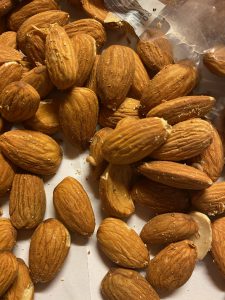
Inspect all pantry items before putting them away to eliminate pests. Photo source: Heidi Copeland
However, I learned that almonds could be the harbinger of a moth. And, as you probably know, moths do not actually start out as a moth but as an egg. In nature, the moth lays an egg and the egg hatches to a larva (caterpillar). Upon maturation, the larva forms its pupa (cocoon) and from the pupa emerges the adult moth, only to start the whole cycle over again! Mating and egg laying begin almost immediately after adults emerge from the pupa.
Raw almonds have NOT been heat treated, thus it is pretty common for the product to contain perhaps an element of surprise. (Note: Eating this product with the worm intact hurts nothing other than our psyche!) Although I am certain my moth was an almond moth, the Indianmeal moth has an attraction for the same pheromone (scent). Thus, after buying food, it is extremely important that ALL pantry goods be examined carefully to eliminate the next generation of adults that can fly and contribute to an infestation. EDIS publication EENY-026 Indianmeal Moth is a great publication with pictures of common hiding places. Moths in particular can be found among tree nuts, grains, cereals, spices, herbs, pasta, starches, flour, and even pet foods.
However, pantry pests are not limited to moths. EDIS publication ENY-213 Pantry and Stored Food Pests has pictures and information of the many species of stored food pests found at various times in food pantries. In fact, there is hardly a food item in the kitchen or food pantry that can escape being infested by some pest if it remains unused and exposed in some dark corner or drawer long enough.
To kill insects in infested foods, place food in an oven at 130 degrees F for 30 minutes or in the freezer at 0 degrees F for four days. If freezing, place the food item in a tightly sealed plastic bag to limit condensation on the product, which can lead to mold growth. Defrost the item in the plastic bag and use the product as soon as possible.
During Covid-19, and now hurricane season, consumers have been encouraged to have food on hand for weeks at a time. Now is a good time to take stock of the pantry and learn how to use the FIFO – first in, first out – system of product rotation. FIFO simply encourages prioritization and the use of stored items, so the oldest products are used first.
The presence of stored food pests is not an indication of uncleanliness, since an insect may be brought home in purchased food or on purchased food packages. However, it is important when purchasing any food product, to inspect your purchase to ensure you do not bring home an insect. Even one insect left alone long enough can cause an infestation.

by Heidi Copeland | Sep 25, 2020
Deep regret and guilt are feelings I experience every time I throw something away in my pantry or refrigerator that I have not quite exhausted. What stays? What goes? Does an expiration date really tell you the WHOLE story?
According to the United States Department of Agriculture (USDA), under the jurisdiction of the Food Safety and Inspection Service (FSIS), manufacturers put dates on food products to let retail stores and consumers know how long their products are expected to be their best quality. Except for infant formula, product dating is not required by Federal regulations.
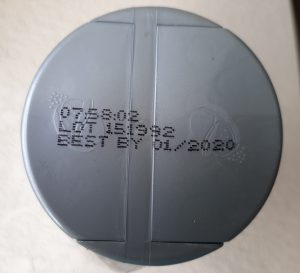
“Best By” date refers to product quality, not safety. Photo source: UF/IFAS NW District
BEST apparently has many interpretations. Food items only need to be labeled in a manner that is truthful and not misleading and in compliance with FSIS regulations.
Many factors determine these quality dates. Additionally, manufacturers and retailers follow strict procedures in the manufacturing, distribution, and storage of food products. However, there is no strict rule to dictate what BEST practices need to be followed once the food leaves the distribution chain and enters, most specifically, our homes. Because of this, food product dating errs on the side of caution.
It has been suggested that date labeling on food products results in consumer confusion and can result in the extraordinary amount of waste at both the retail and consumer level (>30%). Thus, it is important that consumers understand the dates applied to food are for quality, not for safety. The USDA even recognizes that food products are safe to consume past the date on the label, and, regardless of the date, consumers should evaluate the quality of the food product prior to its consumption.
However, it is up to the consumer to understand the significance of product dates and handle food products appropriately.
- “Best if Used By/Before” date indicates when a product will be of best flavor or quality. It is not a purchase or safety date.
- A“Sell-By” date tells the store how long to display the product for sale for inventory management. It is not a safety date.
- “Use-By” date is the last date recommended for the use of the product while at peak quality (it is not a safety date except when used on infant formula).
- “Freeze-By”date indicates when a product should be frozen to maintain peak quality. It is not a purchase or safety date.
- Can codes are a type of closed dating which enables the tracking of product in interstate commerce. These codes also enable manufacturers to rotate their stock and locate their products in the event of a recall. Can codes appear as a series of letters and/or numbers and refer to the date the product was canned. The codes are not meant for the consumer to interpret as a “Best if Used By” date.
Canned goods must exhibit a code or the date of canning. Cans may also display “open” or calendar dates. Usually these are “Best if Used By” dates for peak quality. Discard cans that are dented, rusted, or swollen. High-acid canned foods (e.g. tomatoes and fruits) will keep their best quality for 12 to 18 months; low-acid canned foods (e.g. meats and vegetables) will keep for two to five years.
Additional information on food canning and the handling of canned foods may be found at Shelf-Stable Food Safety.
- Bar Codes on Food Packages are commonly referred to as Universal Product Codes (UPC) and are a type of code that appears on packages as black lines of varying widths above a series of numbers. The UPC is not required by regulation, but manufacturers print them on most product labels because scanners at supermarkets can “read” them quickly to record the price at checkout.
UPCs are also used by stores and manufacturers for inventory purposes and marketing information. When read by a computer, a UPC can reveal such specific information as the manufacturer’s name, product name, size of product, and price. The numbers are not used to identify recalled products.
- Dates on Egg Cartons can indicate either a “Sell-By” or “Expiration” (EXP) date. It is not a federal regulation, but may be required, as defined by the egg laws in the state where the eggs are marketed. Some state egg laws do not allow the use of a “sell-by” date.
Many eggs reach stores only a few days after the hen lays them. Egg cartons with the USDA grade shield on them must display the “pack date” (the day that the eggs were washed, graded, and placed in the carton). This number is a three-digit code that represents the consecutive day of the year starting with January 1 as 001 and ending with December 31 as 365. When a “sell-by” date appears on a carton bearing the USDA grade shield, the code date may not exceed 30 days from the date of pack.
In the United States, after purchasing eggs, it is recommended to refrigerate them in their original carton and place them in the coldest part of the refrigerator, not in the door due to loss of coolness from repeated opening of the door.
The restaurant industry standard, first-in, first-out (FIFO), is also a quick and easy way for the consumer to keep track of their food freshness. FIFO simply means to use food in order of freshness dates. Following the FIFO principle ensures foods with the shortest shelf-life get used first (a permanent marker can help, too).
Throwing something away takes little effort. However, knowing what to keep takes more than a discriminating eye and a keen sense of smell. The Kitchen Companion is a great downloadable resource and reference guide for consumers who are attempting to reduce their own kitchen waste without regret and guilt.
Learn how to be safe, not sorry, without the regret of being wasteful with food products in your home.
Sources:
https://www.fsis.usda.gov/wps/portal/fsis/topics/food-safety-education/get-answers/food-safety-fact-sheets
https://www.fsis.usda.gov/wps/wcm/connect/6c55c954-20a8-46fd-b617-ecffb4449062/Kitchen_Companion_Single.pdf?MOD=AJPERES

by Melanie Taylor | Sep 22, 2020
As I write this article it is the first day of Fall. Many people are enjoying the cooler temperatures, school is in full swing, a few trees are changing colors and everyone is adjusting to shorter days. As Fall begins and we move forward through this unusual and stressful year, many of us need to focus on healthier lifestyles and eating well to be our best self.
Many of us know that fresh fruits and vegetables should be a staple in our daily diets. Apples ripen and are ready for harvest in September or October, making October National Apple Month. So be sure to eat a crisp apple on a nice Fall day. They are refreshing, and you can find ones that are sweet or tart for anyone’s taste buds. They are also a low-calorie food. One medium apple only has about 80 calories. Apples are also a great source of fiber, especially if you eat the peel, and a good source of vitamin C and potassium.
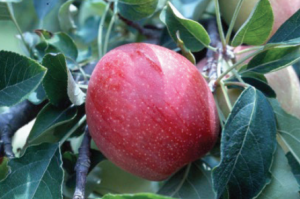
Apple Time
Photo Source: UF/IFAS
Selecting Apples: When selecting apples, they should be smooth skinned, crisp, juicy and a nice color for the variety. Handle apples gently to avoid bruising. Over 2,500 varieties of apples are grown in the United States, and around 100 varieties are grown commercially. Commercially grown apples will be what you see sold in most grocery stores.
Storing Apples: Apples will remain crisp and juicier longer if refrigerated. Store refrigerated apples in plastic bags with small air holes to maintain a high moisture level and delay withering. When storing apples in the refrigerator, they will last 6-8 weeks. Apples stored at room temperature typically last less than a week and lose their crispiness.
Preparing Apples: Simply rinse, refrigerate and enjoy. The best way to prepare your apples is to rinse them under cool tap water and dry with a paper towel. You may use a vegetable brush if you feel it needs more cleaning. Know that when apples arrive to the packing facility, they are washed to remove any dirt from the orchard, but you still need to rinse them. Apples can be cooked, canned, dried and frozen. Be sure to check out some healthy apple recipes from Michigan Apples, and The American Heart Association and preservation recipes from The University of Georgia.
Be sure to enjoy some delicious apples this October!
Sources:
American Heart Association https://www.heart.org
Michigan Applies https://www.michiganapples.com
So Easy to Preserve https://nchfp.uga.edu/
Food and Fitness from Harvest to Health http://missourifamilies.org/

by Angela Hinkle | Sep 15, 2020
Most of us know there is a great deal of cleanup after a disaster hits. But how often do you think about what to clean before disaster strikes?
Here are some helpful cleaning measures you can do before a storm or other calamity so your burden is not so great after.
Outside
Mow the Lawn
If your lawn is mowed low and even now, you won’t have tall grass to trudge through later. Refill any gas cans and/or re-charge any lawnmower batteries after mowing. It will be much easier to pick up and remove any debris that lands on the mown lawn. And you may need to use the gas in the filled can to operate other equipment for the after-cleanup.
Trim, Whack, and Blow
Trim the hedges, whack down those weeds, and blow those leaves now. Otherwise, you may later find yourself with a big mess on top of a big mess.
Bring It In
Bring in any garbage cans, lawn furniture, or other yard items that could make a mess if blown over, broken, or made into dangerous shrapnel.
Inside

Lightning storm. Photo Source: UF/IFAS
Leave No Piles
Make sure there are no dirty dishes in the sink or the dishwasher. Make sure everything is cleaned, dried, and put away. Then, if you lose electricity after the storm or are not sure of the safety of your water, you don’t have to worry about clean plates to eat on, glasses to drink from, or utensils to eat with. And you don’t have a mess to look at or a stink from the sink to deal with.
Clean, dry, and put away all the dirty laundry now. If you lose that all-important electricity later, you won’t have to worry about stepping over piles of clothes or wonder how you’re going to deal with wearing the same dirty clothes over and over again. If you have a generator, you could use that to clean your clothes, but most of the time those generators are best used to keep food safe in the refrigerator or to operate emergency equipment.
Scrub
If your bathroom tub is scrubbed clean now, you can fill it with water for flushing toilets, cleaning, or purifying and using as extra drinking water. You can also take a relaxing, cleansing bath from a hard, dirty day’s work after the storm.
And cleaning a dirty toilet now means you’ll have one less thing to have to deal with later – along with everything else on your to-do list.
Get Rid of It
Make sure the garbage can, recycle bin, and compost container are all emptied. The last thing anyone needs is old piles of trash with new piles of trash added on top.
Been meaning to give away those extra items (knick knacks, doodads, toys, etc.) you don’t use or like anymore? Doing that now makes for a cleaner house as opposed to having more “stuff” in the house, adding to the mess you may have to deal with later.
Clear the Clutter
Pick up papers, bills, tools, and any other important items that may be on various surfaces throughout the house (you may actually want to eat on that dining room table some day). Then organize them together in a safe place. This helps to keep them from getting water damaged or tossed around and you’ll be able to find them later.
Have your emergency kit filled and ready to go in a plastic tub or waterproof container. Make sure everyone in the house knows where it is. For other disaster preparation and recovery resources, go to https://disaster.ifas.ufl.edu/ and/or talk with your county UF/IFAS Extension Agent.
If your home or property are destroyed in a disaster, these measures probably won’t really help much. But if all is not lost and there is just some debris and damage cleanup to be done after a large weather event, the above measures taken before can alleviate a lot of extra stress after. And if there is no disaster, hey, your house is nice and clean. Relax and enjoy it!
Make sure you clean before disaster strikes.












